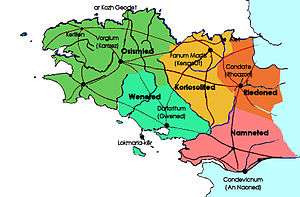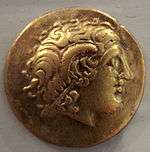Riedones
The Riedones (also Redones or Rhedones) were a Gallic tribe, dwelling around their capital Condate (modern Rennes). Caesar mentions the Redones among the civitates maritimae or Aremoricae.[1]
Name
They are mentioned as R[h]edones by Caesar (mid-1st c. BC),[2] as Rhedones by Pliny (1st c. AD),[3] as Rhiḗdones (‛Ριήδονες), Rhḗdones (Ῥήδονες) and Rhēḯdones (Ῥηΐδονες) by Ptolemy (2nd c. AD),[4] and as Redonas in the Notitia Dignitatum (5th c. AD).[5][6] Their chief town is also attested on inscriptions as civ]itas Ried[onum and [civ]itas Ried[onum].[7][6]
The name Redones ('charriot-drivers') stems from the Gaulish root rēdo- ('riding horseback, driving a horse-led chariot, travelling'), ultimately from Proto-Celtic *rēdo- ('the act of riding, chariot'; compare with Old Irish ríad 'riding, driving a horse, voyage'; Gallo-Latin rēda 'chariot').[8][9][10]
The city of Rennes, attested as civitas Redonum ca. 400 AD ('civitas of the Redones'; Redonis civitate in the 9th c. AD; Rennes in 1294) is named after the Gallic tribe.[11]
Geography
In the Celtogalatia Lugdunensis of Ptolemy (ii. 8. § 12), he placed them west of the Senones and along the Liger (modern Loire River). But other authors contend that the Redones were not on the Loire. Pliny (iv. 18) enumerates the Redones among the peoples of Gallia Lugdunensis: Diablindi, Rhedones, Turones.
History
After the bloody fight on the Sambre (57 BCE) Julius Caesar sent Publius Licinius Crassus with a single legion into the country of the Veneti, Redones, and other Celtic tribes between the Seine River and the Loire, all of whom submitted. (B. G. ii. 34.) Caesar here enumerates the Redones among the maritime states whose territory extends to the Atlantic Ocean. In 52 BCE the Redones with their neighbors sent a contingent to attack Caesar during the siege of Alesia. In this passage also (B. G. vii. 75), the Redones are enumerated among the states bordering on the ocean, which in the Celtic language were called the Armoric States. D'Anville supposes that their territory extended beyond the limits of the diocese of Rennes into the dioceses of St. Malo and Dol-de-Bretagne.
References
- Lafond & Olshausen 2006.
- Caesar. Commentarii de Bello Gallico. 2:34; 7:75
- Pliny. Naturalis Historia, 4:107
- Ptolemy. Geōgraphikḕ Hyphḗgēsis, 2:8:2; 2:8:9
- Notitia Dignitatum. or 42:36
- Falileyev 2010, entry 994b.
- Corpus Inscriptionum Latinarum, 13:3151; 3152.
- Lambert 1994, p. 34.
- Delamarre 2003, p. 256.
- Matasović 2009, p. 307.
- Nègre 1990, p. 156.
Bibliography
- Delamarre, Xavier (2003). Dictionnaire de la langue gauloise: Une approche linguistique du vieux-celtique continental (in French). Errance. ISBN 9782877723695.CS1 maint: ref=harv (link)
- Falileyev, Alexander (2010). Dictionary of Continental Celtic Place-names: A Celtic Companion to the Barrington Atlas of the Greek and Roman World. CMCS. ISBN 978-0955718236.
- Lambert, Pierre-Yves (1994). La langue gauloise: description linguistique, commentaire d'inscriptions choisies (in French). Errance. ISBN 978-2-87772-089-2.CS1 maint: ref=harv (link)
- Matasović, Ranko (2009). Etymological Dictionary of Proto-Celtic. Brill. ISBN 9789004173361.CS1 maint: ref=harv (link)
- Nègre, Ernest (1990). Toponymie générale de la France (in French). Librairie Droz. ISBN 978-2-600-02883-7.CS1 maint: ref=harv (link)
- Lafond, Yves; Olshausen, Eckart (2006). "Redones". Brill’s New Pauly.
![]()

